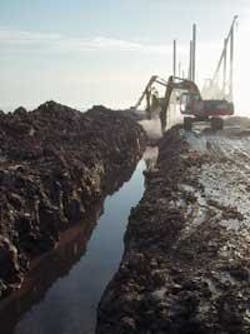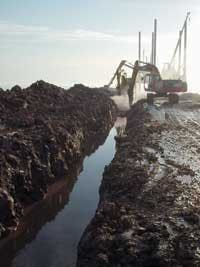Seacore digs in at Girvan
By Rodney Byles
The UK company Seacore, based in Cornwall, successfully completed the construction of a new wastewater sea outfall pipeline at Girvan on the exposed west coast of Scotland, about 100 km south of Glasgow.
Seacore designed, developed and uses its own bespoke equipment on its various worldwide marine projects. The company employs drill and blast techniques to pre-treat the ground and innovative trenching equipment, combined with an integral pipe laying system, to install the pipeline. Using its modular Skate IV jack-up platform, Seacore deployed its hydraulically operated stem mounted trenching grab onto a cantilevered finger pontoon that travels the length of one side of the jack-up.
This arrangement enabled Seacore to accurately excavate a 2-m-deep, 1.5-m-wide trench in the seabed in up to 22m of water, well within the maximum 14-m water depth at Girvan. The spoil is precisely side cast in a windrow parallel and up to 10m away from the excavation, ready for reuse as backfill. Once a 24-m-long section of trench has been excavated, the platform is jacked down, moved and repositioned for trenching to continue on the next section of the pipeline. Concurrent with the repositioning of the platform, the polyethylene outfall pipe, complete with concrete ballast collars, is slowly fed off the stinger frame on the end of the platform, and guided into the previously excavated trench. A bottom dump barge immediately follows on placing a covering of beach gravel prior to the attendant Multicat support vessel using a seabed profiler to place the excavated spoil back into the trench to complete the pipe protection.
This sequence is repeated to complete the construction of the outfall section of pipe prior to the installation of the final 15-m-long diffuser pipe work assembly, surrounding gabion scour protection mats and diffuser protection modules. The diffuser components are positioned using a combination of Skate IV's onboard pedestal crane and diver assistance.
Working round the clock in two 12-hour shifts, Seacore completed the 1,100-m marine outfall works in 11 weeks, which the company claims is very good progress in such exposed conditions and with unpredictable weather. Seacore completed the marine works by mid-September 2003, with the entire project being commissioned three weeks ahead of programme.
Within the works, Seacore had to treat 290 linear metres of trench route with drill and blast prior to excavation, which was performed from the jack-up without diver intervention. "One of the major advantages of our fully integrated trenching system is that we can do all the drilling, charging the holes, blasting and excavation directly from the jack-up without putting divers in the water," Seacore Project Manager Les Lugg said. "We had our explosives consultant, ABCO Divers from Belfast, Ireland, design a drill pattern and charge to produce a steep-sided trench and give us the fragmentation we require, so the excavated spoil would not be moved by the tidal currents and stay in the windrow after excavation ready for backfilling."
Mr. Lugg continued: "Our modified Skate IV jack-up, with its integral digger leg, grab and stinger, is ideal for pipe laying in up to 22m of water. The system provides totally controlled and precise digging combined with precision pipe laying and backfilling of the trench. This is very accurate and precise trenching equipment and there is no need for inspection divers or intermediate bathymetric surveys to check seabed and trench levels, as all surveying is done from onboard the jack-up. We can accurately excavate 24m of trench at a time and using the onboard stinger launching system can feed and place the pipe in the trench straight away, instead of leaving it open for days with the inherent risk of it backfilling by tidal currents."
Author's Note
Rodney Byles is a writer specialising in the civil engineering and construction plant industries. He is based in Farnham Common, Buckinghamshire, England.

